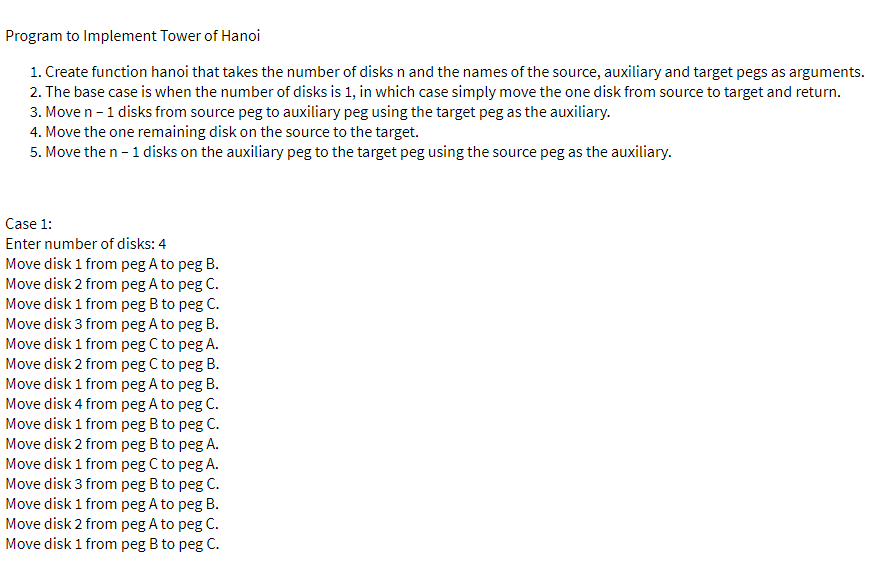Program to Implement Tower of Hanoi 1. Create function hanoi that takes the number of disks n and the names of the source, auxiliary and target pegs as arguments. 2. The base case is when the number of disks is 1, in which case simply move the one disk from source to target and return. 3. Move n - 1 disks from source peg to auxiliary peg using the target peg as the auxiliary. 4. Move the one remaining disk on the source to the target. 5. Move the n-1 disks on the auxiliary peg to the target peg using the source peg as the auxiliary.
Program to Implement Tower of Hanoi 1. Create function hanoi that takes the number of disks n and the names of the source, auxiliary and target pegs as arguments. 2. The base case is when the number of disks is 1, in which case simply move the one disk from source to target and return. 3. Move n - 1 disks from source peg to auxiliary peg using the target peg as the auxiliary. 4. Move the one remaining disk on the source to the target. 5. Move the n-1 disks on the auxiliary peg to the target peg using the source peg as the auxiliary.
C++ Programming: From Problem Analysis to Program Design
8th Edition
ISBN:9781337102087
Author:D. S. Malik
Publisher:D. S. Malik
Chapter12: Points, Classes, Virtual Functions And Abstract Classes
Section: Chapter Questions
Problem 19SA
Related questions
Question
urgently needed

Transcribed Image Text:Program to Implement Tower of Hanoi
1. Create function hanoi that takes the number of disks n and the names of the source, auxiliary and target pegs as arguments.
2. The base case is when the number of disks is 1, in which case simply move the one disk from source to target and return.
3. Move n- 1 disks from source peg to auxiliary peg using the target peg as the auxiliary.
4. Move the one remaining disk on the source to the target.
5. Move the n - 1 disks on the auxiliary peg to the target peg using the source peg as the auxiliary.
Case 1:
Enter number of disks: 4
Move disk 1 from peg A to peg B.
Move disk 2 from peg A to peg C.
Move disk 1 from peg B to peg C.
Move disk 3 from peg A to peg B.
Move disk 1 from peg C to peg A.
Move disk 2 from peg C to peg B.
Move disk 1 from peg A to peg B.
Move disk 4 from peg A to peg C.
Move disk 1 from peg B to peg C.
Move disk 2 from peg B to peg A.
Move disk 1 from peg C to peg A.
Move disk 3 from peg B to peg C.
Move disk 1 from peg A to peg B.
Move disk 2 from peg A to peg C.
Move disk 1 from peg B to peg C.
Expert Solution
This question has been solved!
Explore an expertly crafted, step-by-step solution for a thorough understanding of key concepts.
This is a popular solution!
Trending now
This is a popular solution!
Step by step
Solved in 4 steps with 2 images

Knowledge Booster
Learn more about
Need a deep-dive on the concept behind this application? Look no further. Learn more about this topic, computer-science and related others by exploring similar questions and additional content below.Recommended textbooks for you

C++ Programming: From Problem Analysis to Program…
Computer Science
ISBN:
9781337102087
Author:
D. S. Malik
Publisher:
Cengage Learning

Microsoft Visual C#
Computer Science
ISBN:
9781337102100
Author:
Joyce, Farrell.
Publisher:
Cengage Learning,

C++ Programming: From Problem Analysis to Program…
Computer Science
ISBN:
9781337102087
Author:
D. S. Malik
Publisher:
Cengage Learning

Microsoft Visual C#
Computer Science
ISBN:
9781337102100
Author:
Joyce, Farrell.
Publisher:
Cengage Learning,